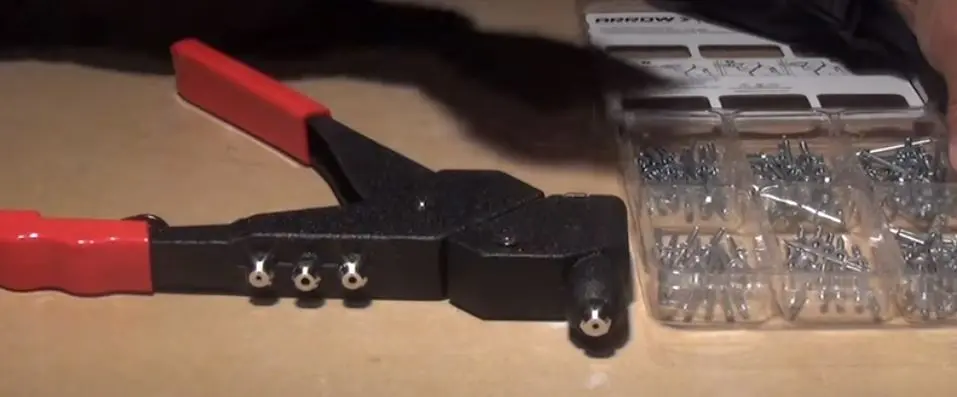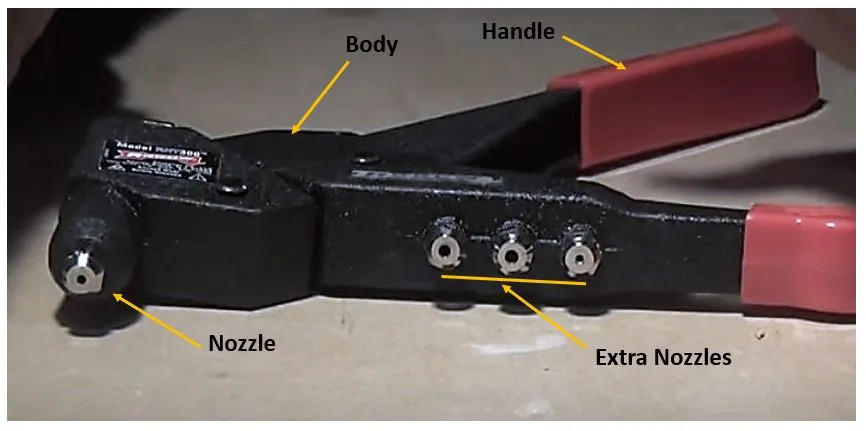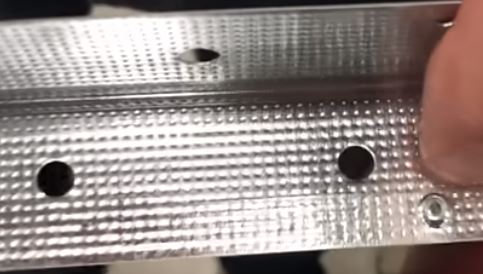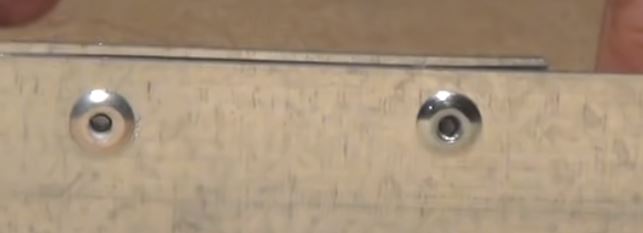In the realm of manufacturing and construction, where strong and reliable connections are paramount, rivet guns stand as unsung heroes. These unassuming tools possess the ability to create lasting bonds between materials, enhancing structural integrity and efficiency in a multitude of industries.
In this blog post, we embark on a riveting journey to uncover the inner workings of these powerful devices. From understanding the fundamental principles that govern their operation to exploring the various types available, we’ll equip you with essential knowledge to master the art of rivet guns.
What is a rivet gun?

A rivet gun is a type of handheld tool used for fastening or joining two or more materials together using rivets. Rivets are mechanical fasteners that consist of a cylindrical shaft with a head on one end. They are often made of metal and come in various sizes and materials to suit different applications.
The process of using a rivet gun involves inserting a rivet into pre-drilled holes in the materials to be joined. The rivet gun then deforms the tail of the rivet, creating a second head on the opposite side and effectively clamping the materials together securely.
Rivet guns are commonly used in industries such as construction, manufacturing, automotive, aerospace, and even in some DIY projects.
They are particularly useful when joining materials that are difficult to weld, solder, or otherwise fasten using traditional methods. Additionally, rivets provide a reliable and robust joint that can withstand significant loads and vibrations.
There are various types of rivet guns, including hand-operated models for lighter applications and pneumatic or hydraulic rivet guns for heavier-duty work.
The specific type of rivet gun used depends on the size and material of the rivets, as well as the requirements of the project at hand.
Parts of a rivet gun

The basic parts of a rivet gun include:
- Body: The main body of the rivet gun houses all the internal components and provides structural support for the tool.
- Handle: The handle is the part of the rivet gun that the operator grips while using the tool. It is typically designed for comfort and ease of use.
- Trigger: The trigger is located on the handle and is used to activate the rivet gun. When the operator squeezes the trigger, it initiates the riveting process.
- Nosepiece: The nosepiece is the front end of the rivet gun, where the rivet is placed before insertion. It comes in various sizes to accommodate different rivet diameters.
- Jaws: Inside the nosepiece, there are jaws that grip and hold the rivet in place during the riveting process. They ensure that the rivet remains steady while the gun forms the head.
- Mandrel Collector (in certain types): For pop rivet guns that use blind rivets, there is a mandrel collector at the back. When the rivet is installed, the mandrel (the stem of the rivet) breaks off and is collected in this compartment for easy disposal.
- Spring Mechanism: The rivet gun employs a spring mechanism to deliver the force needed to drive the rivet into the materials being joined. When the trigger is pulled, the spring is compressed, and upon release, it releases the energy to complete the riveting action.
These are the essential parts found in most rivet guns. The specific design and additional features may vary depending on the type and model of the rivet gun.
Some rivet guns, particularly the pneumatic and hydraulic types used in industrial settings, may have additional components to accommodate their power source and enhance performance.
Regardless of the variation, these basic parts work together to ensure a reliable and secure fastening process when using rivet guns.
How does a rivet gun work?
A rivet gun works by deforming a rivet to create a permanent joint between two or more materials. Follow the following steps to work with the rivet gun:
Preparation

The materials to be joined are positioned together, and the appropriate size and type of rivet are selected based on the application’s requirements.
Drilling

If the materials do not already have holes for the rivets, they are pre-drilled at the desired locations. The size and diameter of the holes should match the specifications of the rivet being used.
Inserting the Rivet

The rivet is inserted through the holes in the materials. One end of the rivet should have a head, which will be referred to as the “factory head,” and the other end will be called the “tail.”
Actuating the Rivet Gun

The rivet gun is activated, either by squeezing the handles of a hand-operated rivet gun or by using compressed air or hydraulic power for pneumatic or hydraulic rivet guns.
Deforming the Rivet

When the rivet gun is activated, it pulls the tail of the rivet, causing the shaft of the rivet to deform and expand. This deformation creates a second head on the tail end of the rivet which is known as shop head, effectively clamping the materials together.
Completion

Once the rivet is fully deformed and the joint is secure, the rivet gun is released, and the riveting process is complete.
As a result of this process, the rivet forms a strong and permanent bond between the materials, creating a reliable joint that can withstand various stresses and loads.
It is essential to use the appropriate size and type of rivet for the specific application to ensure a successful and long-lasting joint. Additionally, the operator should follow safety guidelines and proper riveting techniques to avoid any accidents or improper installations.
Types of rivet gun
There are several types of rivet guns, each designed for specific applications and varying in their operation. The main types of rivet guns include:
Hand Rivet Gun
This is the most basic type of rivet gun and is manually operated. It is suitable for lighter-duty applications and is often used in DIY projects or small-scale riveting tasks. Hand rivet guns are easy to use and do not require any external power source.
Pneumatic Rivet Gun
Pneumatic rivet guns, also known as air rivet guns, are powered by compressed air. They are more powerful than hand rivet guns and can handle heavier-duty applications. Pneumatic rivet guns are commonly used in manufacturing, construction, and automotive industries.
Hydraulic Rivet Gun
Hydraulic rivet guns use hydraulic pressure to deform rivets. They are even more powerful than pneumatic rivet guns and are typically used for heavy-duty applications in industries like shipbuilding, aerospace, and structural construction.
Battery-Powered Rivet Gun
Battery-powered rivet guns are cordless and use rechargeable batteries for their operation. They provide more mobility compared to pneumatic or hydraulic rivet guns, making them suitable for remote or hard-to-reach locations.
Cordless Electric Rivet Gun
Similar to battery-powered rivet guns, cordless electric rivet guns use electric power but without the need for air compression. They offer good portability and are more convenient for on-the-go riveting tasks.
Spin-Pull Rivet Gun
Spin-pull rivet guns are designed specifically for installing spin-pull rivets. These rivets have internal threads, and the spin-pull rivet gun rotates the rivet while pulling the mandrel (the central pin) to deform the rivet and form the joint.
Squeeze Riveter
Squeeze riveters, also known as compound or lever riveters, use compound leverage to deform the rivet. They are often used in aerospace and sheet metal fabrication industries, where precision and control are essential.
Each type of rivet gun has its advantages and is suitable for different applications. The choice of rivet gun depends on factors such as the materials being joined, the size of the rivets, the required strength of the joint, and the available power sources. Safety considerations should also be taken into account when selecting and operating a rivet gun.
What is a pop rivet gun?
A pop rivet gun, also known as a blind rivet gun or a rivet popper, is a specific type of rivet gun used to install pop rivets. Pop rivets are a type of fastener that is commonly used to join two or more materials together, especially in situations where the backside of the materials is not easily accessible.
Pop rivets consist of a tubular rivet body with a mandrel (a central pin) through its hollow center. The rivet gun is designed to pull the mandrel while holding the rivet body in place, causing the end of the rivet to expand and form a second head, creating a secure and tight joint between the materials.
Here’s how a pop rivet gun works:
- Preparation: The materials to be joined are positioned together, and the appropriate size and type of pop rivet are selected based on the application’s requirements.
- Drilling (if necessary): If the materials do not have pre-drilled holes for the pop rivets, holes are drilled in the materials to match the diameter of the rivet body.
- Inserting the Pop Rivet: The pop rivet is inserted into the pre-drilled holes, and the mandrel end protrudes from the side of the materials.
- Placing the Pop Rivet Gun: The pop rivet gun’s nosepiece is placed over the exposed mandrel end of the pop rivet.
- Actuating the Pop Rivet Gun: When the pop rivet gun is activated, it pulls the mandrel while holding the rivet body in place. As the mandrel is pulled, it deforms the rivet body and expands the tail end, creating a second head on the blind side of the materials.
- Breaking Off the Mandrel: Once the rivet is fully expanded and the joint is secure, the excess mandrel is broken off, leaving a neat and flush finish on the visible side of the materials.
Pop rivet guns are easy to use, relatively lightweight, and provide a quick and efficient way to join materials in applications where access to both sides of the materials is limited.
They are commonly used in various industries, including automotive, construction, sheet metal fabrication, and more.
Pop rivets offer a strong and reliable joint and are an excellent choice for applications that require a secure connection without the need for welding or other permanent fastening methods.
What is blind rivet gun?
A blind rivet gun, also known as a blind riveter or a pop riveter, is a type of rivet gun specifically designed for installing blind rivets. Blind rivets are fasteners used to join two or more materials together, especially when access to the backside of the materials is limited or impossible.
Blind rivets consist of a tubular body with a mandrel (a central pin) through its hollow center. The blind rivet gun is designed to pull the mandrel while holding the rivet body in place, causing the end of the rivet to expand and form a second head on the blind side of the materials.
This creates a secure and tight joint between the materials, and the excess mandrel is then broken off to leave a neat and flush finish on the visible side.
The term “blind” in blind rivets refers to the fact that the installation process can be performed from one side of the materials, without the need for access to the opposite side.
This characteristic makes blind rivets and blind rivet guns particularly useful in situations where the backside of the materials is not easily accessible, such as when joining materials with limited access or in enclosed spaces.
Blind rivet guns come in various styles, including hand-operated, pneumatic (air-powered), and hydraulic models. The choice of blind rivet gun depends on the specific application’s requirements, the size of the blind rivets being used, and the available power sources.
Blind rivet guns are commonly used in industries such as automotive, construction, metal fabrication, aerospace, and more, as well as in various DIY projects where secure and efficient fastening is needed. They offer a reliable and quick method for joining materials without the need for welding, nuts, or other permanent fasteners.


